MERCEDES-BENZ R-CLASS MPV 2008 Workshop Manual
Manufacturer: MERCEDES-BENZ, Model Year: 2008, Model line: R-CLASS MPV, Model: MERCEDES-BENZ R-CLASS MPV 2008Pages: 373, PDF Size: 6.75 MB
Page 51 of 373

Occupant safety
48 If a child opens a door, the child or other
persons could be injured as a result. The
child could get out and be injured in the
process or be injured by a passing vehicle. G
Risk of injury
An unsecured or incorrectly positioned load
increases the risk of injury to the child in
the event of:
R an accident
R a braking manoeuvre
R a sudden change of direction
Do not carry heavy or hard objects inside
the vehicle unless they are secured. You
will find further information under "Loading
guidelines" in the index.
Child restraint systems Mercedes-Benz recommends that you only
use the child restraint systems listed on.
(Y page 53) G
Risk of injury
To reduce the risk of serious or even fatal
injury to the child in the event of a sudden
change in direction, braking or an accident:
R children less than 1.50 m tall and under
twelve years of age must always be
secured in special child restraint systems
on a suitable vehicle seat. This is neces-
sary because the seat belts are not
designed for children of this size.
R do not secure children under twelve
years of age on the front-passenger seat.
Exception: the child is secured in a vehi-
cle with automatic child seat recognition
on the front-passenger seat* and is
secured in a child restraint system with
automatic child seat recognition.
R if you secure a forward-facing child
restraint system to the front-passenger
seat that is not equipped with automatic
child seat recognition, you must move
the front-passenger seat as far back as
possible.
R children must never travel sitting on the
lap of another occupant. Due to the
forces occurring in the event of a sudden
change of direction, heavy braking or an accident, it would not be possible to
restrain the child. The child could be
thrown against parts of the vehicle inte-
rior and be seriously or even fatally
injured.
G
Risk of injury
The child restraint system cannot perform
its protective function if is not correctly fit-
ted to a suitable vehicle seat. The child
cannot be restrained in the event of a sud-
den change of direction, heavy braking or
an accident. This may lead to serious or
even fatal injuries. For this reason, when
fitting a child restraint system, observe the
manufacturer's installation instructions
and the correct use of the child restraint
system.
Child restraint systems should preferably
be fitted to the rear seats. Children are gen-
erally better protected there.
The entire base of the child restraint system
must always rest on the seat cushion.
Never place objects, e.g. a cushion, under
the child restraint system.
Only use child restraint systems with their
original covers. Only replace damaged cov-
ers with genuine Mercedes-Benz covers. Safety
* optional
251_AKB; 5; 7, en-GB
wobuchh,
Version: 2.10.6 2008-05-11T14:51:51+02:00 - Seite 48Dateiname: 6515_1825_02_buchblock.pdf; preflight
Page 52 of 373

Occupant safety
49For safety reasons, you should only use
child restraint systems which have been
approved for use in Mercedes-Benz vehi-
cles.
Child seat on the front-passenger seat Warning on the front-passenger sun visor Warning symbol for a rearward-facing child
restraint system
G
Risk of injury
If the front-passenger front airbag is not
disabled:
R a child secured in a child restraint system
on the front-passenger seat could be
seriously and even fatally injured by the
front-passenger front airbag deploying.
This is especially a risk if the child is in
the immediate vicinity of the front-
passenger front airbag when it deploys.
R a child must never be secured on the
front-passenger seat in a rearward-facing
child restraint system. Only secure a rearward-facing child restraint system on
a suitable rear seat.
R always move the front-passenger seat to
the rearmost position if you secure a
child in a forward-facing child restraint
system on the front-passenger seat.
The front-passenger front airbag is not dis-
abled:
R on vehicles without automatic child seat
recognition in the front-passenger
seat*.
R on vehicles without automatic child seat
recognition on the front-passenger
seat*, if no special child restraint system
with automatic child seat recognition has
been fitted to the front-passenger seat.
R on vehicles with automatic child seat rec-
ognition on the front-passenger seat*, if
the 5 PASSENGER AIRBAG OFF warn-
ing lamp is not lit.
To draw attention to this danger, there is an
appropriate warning sticker on the dash-
board as well as on both sides of the sun
visor on the front-passenger side. Safety
* optional
251_AKB; 5; 7, en-GB
wobuchh,
Version: 2.10.6 2008-05-11T14:51:51+02:00 - Seite 49 ZDateiname: 6515_1825_02_buchblock.pdf; preflight
Page 53 of 373

Occupant safety
50 Information about recommended child
restraint systems is available at any
Mercedes-Benz Service Centre.
Automatic child seat recognition on the
front-passenger seat*
If your vehicle does not have automatic child
seat recognition on the front-passenger seat,
this is indicated by a special sticker. The
sticker is affixed to the side of the dashboard
on the front-passenger side. It is visible when
you open the front-passenger door.
The warning lamp 13
is located on the centre
console. 1
5 PASSENGER AIRBAG OFF warning
lamp The front-passenger seat sensor system for
child restraint systems detects whether a
special Mercedes-Benz child seat with auto-
matic child seat recognition has been fitted.
In such cases,
5PASSENGER AIRBAG
OFF indicator lamp 1lights up. The front-
passenger airbag is deactivated. G
Risk of injury
If the 5 PASSENGER AIRBAG OFF warn-
ing lamp does not light up when the child
restraint system is fitted, the front-
passenger front airbag has not been disa-
bled. If the front-passenger front airbag is
deployed, the child could be seriously or
even fatally injured.
Proceed as follows:
R do not use a rearward-facing child
restraint system on the front-passenger
seat.
R fit a rearward-facing child restraint sys-
tem on a suitable rear seat.
or
R only use a forward-facing child restraint
system on the front-passenger seat and move the front-passenger seat to its rear-
most position.
R have the automatic child seat recognition
checked at a qualified specialist work-
shop.
To ensure that the automatic child seat rec-
ognition on the front-passenger seat func-
tions correctly, never place objects (such
as a cushion) under the child restraint sys-
tem. The entire base of the child restraint
system must always rest on the seat cush-
ion. An incorrectly fitted child restraint sys-
tem cannot perform its intended protective
function in the event of an accident, and
could lead to injuries.
i The windowbag, the sidebag and the belt
tensioner on the front-passenger side are
still active even when the front-passenger
front airbag is disabled.
13 Vehicles without automatic child seat recognition in the front-passenger seat: the warning lamp lights up briefly when you turn the key to position 2 in the ignition
lock. However, it has no function and does not indicate that there is automatic child seat recognition on the front-passenger seat. Safety
* optional
251_AKB; 5; 7, en-GB
wobuchh,
Version: 2.10.6 2008-05-11T14:51:51+02:00 - Seite 50Dateiname: 6515_1825_02_buchblock.pdf; preflight
Page 54 of 373

Occupant safety
51G
Risk of injury
Do not place items of electronic equipment
on the front-passenger seat, e.g.:
R laptops, when switched on
R mobile phones
R cards with transponders, e.g. ski passes
or access cards Signals from electronic equipment can
cause interference in the automatic child
seat recognition sensor system. This could
lead to a system malfunction. This may
cause the 5PASSENGER AIRBAG OFF
warning lamp to light up without there
being a child seat with automatic child seat
recognition fitted. This means that the front-passenger airbag does not deploy
during an accident. It is also possible that
the
5 PASSENGER AIRBAG OFF warning
lamp will not light up briefly if you turn the
key in the ignition lock to position 2.
Suitable positioning of the child restraint system Weight categories and
ages Child restraint system
on the front-
passenger seat 2nd row of seats:
child restraint sys-
tem on the left-hand
and right-hand seats 2nd row of seats: child
restraint system on
the centre rear seat
3rd row of seats*: child
restraint system
Group 0: up to 10 kg;
up to approx. 9 months Vehicles with automatic
child seat recognition*
on the front-passenger
seat: as recommen-
ded
14 Universal
15 As recommended Universal
Group 0+: up to 13 kg;
up to approx. 18 months 14
Only use child restraint systems with automatic child seat recognition.
15 Position the rear seat backrest vertically. Safety
* optional
251_AKB; 5; 7, en-GB
wobuchh,
Version: 2.10.6 2008-05-11T14:51:51+02:00 - Seite 51 ZDateiname: 6515_1825_02_buchblock.pdf; preflight
Page 55 of 373

Occupant safety
52 Weight categories and
ages Child restraint system
on the front-
passenger seat 2nd row of seats:
child restraint sys-
tem on the left-hand
and right-hand seats 2nd row of seats: child
restraint system on
the centre rear seat
3rd row of seats*: child
restraint system Group I: 9 to 18 kg;
between approx. 8 months
and 4 years As recommended
16 Universal
15 As recommended Universal
Group II/III: 15 to 36 kg;
between approx. 3½ and
12 years Not suitable
Universal
15 As recommended Universal
16
If you are using a child restraint system without automatic child seat recognition, move the front-passenger seat to its rearmost position.
15 Position the rear seat backrest vertically. Safety
* optional
251_AKB; 5; 7, en-GB
wobuchh,
Version: 2.10.6 2008-05-11T14:51:51+02:00 - Seite 52Dateiname: 6515_1825_02_buchblock.pdf; preflight
Page 56 of 373
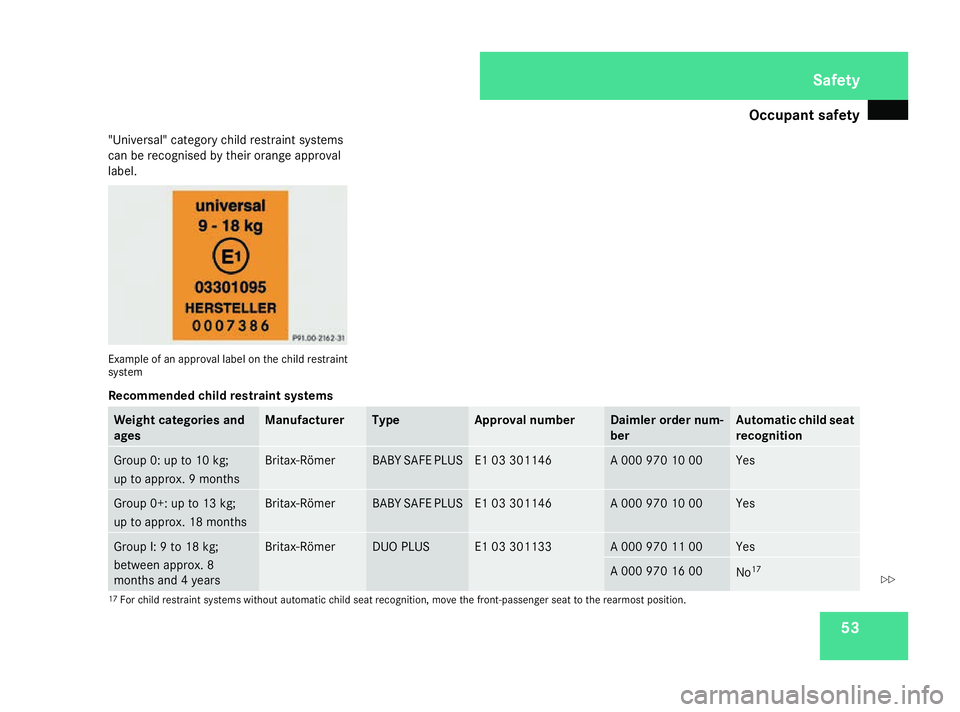
Occupant safety
53
"Universal" category child restraint systems
can be recognised by their orange approval
label. Example of an approval label on the child restraint
system
Recommended child restraint systems Weight categories and
ages Manufacturer Type Approval number Daimler order num-
ber Automatic child seat
recognition
Group 0: up to 10 kg;
up to approx. 9 months Britax-Römer BABY SAFE PLUS E1 03 301146 A 000 970 10 00 Yes
Group 0+: up to 13 kg;
up to approx. 18 months Britax-Römer BABY SAFE PLUS E1 03 301146 A 000 970 10 00 Yes
Group I: 9 to 18 kg;
between approx. 8
months and 4 years Britax-Römer DUO PLUS E1 03 301133 A 000 970 11 00 Yes
A 000 970 16 00
No
17 17
For child restraint systems without automatic child seat recognition, move the front-passenger seat to the rearmost position. Safety
251_AKB; 5; 7, en-GB
wobuchh,
Version: 2.10.6 2008-05-11T14:51:51+02:00 - Seite 53 ZDateiname: 6515_1825_02_buchblock.pdf; preflight
Page 57 of 373
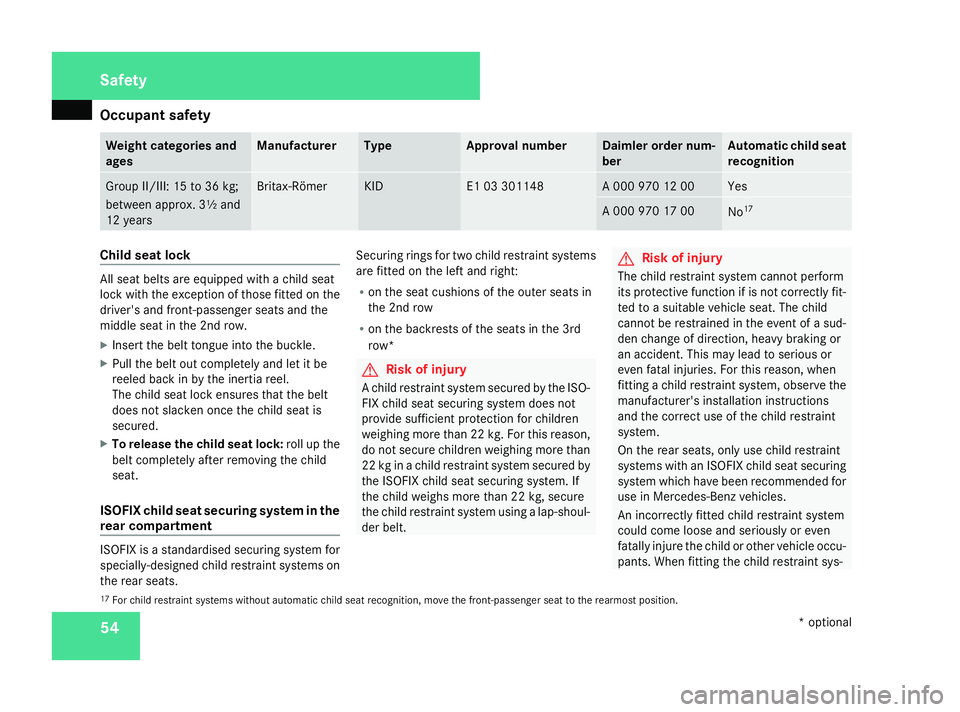
Occupant safety
54 Weight categories and
ages Manufacturer Type Approval number Daimler order num-
ber Automatic child seat
recognition
Group II/III: 15 to 36 kg;
between approx. 3½ and
12 years Britax-Römer KID E1 03 301148 A 000 970 12 00 Yes
A 000 970 17 00
No
17 Child seat lock
All seat belts are equipped with a child seat
lock with the exception of those fitted on the
driver's and front-passenger seats and the
middle seat in the 2nd row.
X Insert the belt tongue into the buckle.
X Pull the belt out completely and let it be
reeled back in by the inertia reel.
The child seat lock ensures that the belt
does not slacken once the child seat is
secured.
X To release the child seat lock: roll up the
belt completely after removing the child
seat.
ISOFIX child seat securing system in the
rear compartment ISOFIX is a standardised securing system for
specially-designed child restraint systems on
the rear seats. Securing rings for two child restraint systems
are fitted on the left and right:
R
on the seat cushions of the outer seats in
the 2nd row
R on the backrests of the seats in the 3rd
row* G
Risk of injury
A child restraint system secured by the ISO-
FIX child seat securing system does not
provide sufficient protection for children
weighing more than 22 kg. For this reason,
do not secure children weighing more than
22 kg in a child restraint system secured by
the ISOFIX child seat securing system. If
the child weighs more than 22 kg, secure
the child restraint system using a lap-shoul-
der belt. G
Risk of injury
The child restraint system cannot perform
its protective function if is not correctly fit-
ted to a suitable vehicle seat. The child
cannot be restrained in the event of a sud-
den change of direction, heavy braking or
an accident. This may lead to serious or
even fatal injuries. For this reason, when
fitting a child restraint system, observe the
manufacturer's installation instructions
and the correct use of the child restraint
system.
On the rear seats, only use child restraint
systems with an ISOFIX child seat securing
system which have been recommended for
use in Mercedes-Benz vehicles.
An incorrectly fitted child restraint system
could come loose and seriously or even
fatally injure the child or other vehicle occu-
pants. When fitting the child restraint sys-
17 For child restraint systems without automatic child seat recognition, move the front-passenger seat to the rearmost position. Safety
* optional
251_AKB; 5; 7, en-GB
wobuchh,
Version: 2.10.6 2008-05-11T14:51:51+02:00 - Seite 54Dateiname: 6515_1825_02_buchblock.pdf; preflight
Page 58 of 373
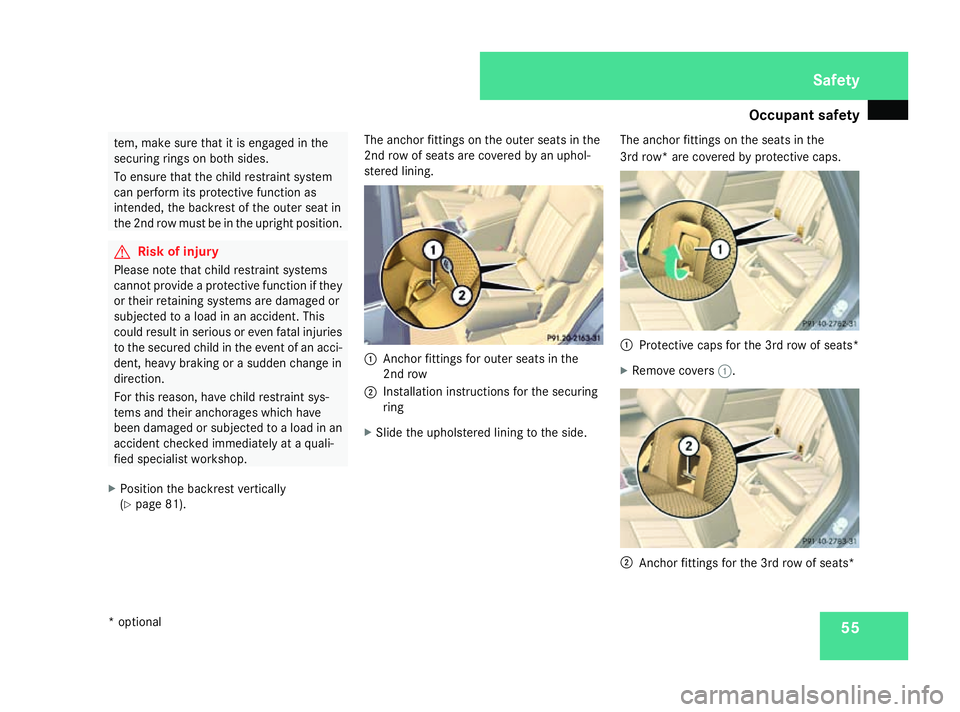
Occupant safety
55tem, make sure that it is engaged in the
securing rings on both sides.
To ensure that the child restraint system
can perform its protective function as
intended, the backrest of the outer seat in
the 2nd row must be in the upright position. G
Risk of injury
Please note that child restraint systems
cannot provide a protective function if they
or their retaining systems are damaged or
subjected to a load in an accident. This
could result in serious or even fatal injuries
to the secured child in the event of an acci-
dent, heavy braking or a sudden change in
direction.
For this reason, have child restraint sys-
tems and their anchorages which have
been damaged or subjected to a load in an
accident checked immediately at a quali-
fied specialist workshop.
X Position the backrest vertically
(Y page 81). The anchor fittings on the outer seats in the
2nd row of seats are covered by an uphol-
stered lining.
1
Anchor fittings for outer seats in the
2nd row
2 Installation instructions for the securing
ring
X Slide the upholstered lining to the side. The anchor fittings on the seats in the
3rd row* are covered by protective caps. 1
Protective caps for the 3rd row of seats*
X Remove covers 1. 2
Anchor fittings for the 3rd row of seats* Safety
* optional
251_AKB; 5; 7, en-GB
wobuchh,
Version: 2.10.6 2008-05-11T14:51:51+02:00 - Seite 55 ZDateiname: 6515_1825_02_buchblock.pdf; preflight
Page 59 of 373
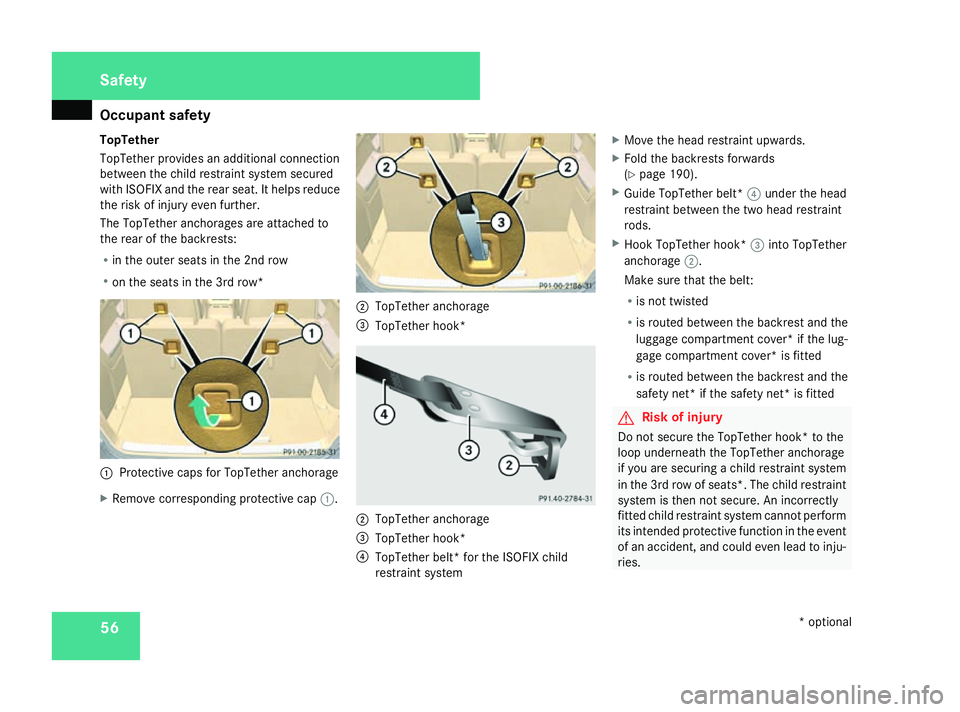
Occupant safety
56
TopTether
TopTether provides an additional connection
between the child restraint system secured
with ISOFIX and the rear seat. It helps reduce
the risk of injury even further.
The TopTether anchorages are attached to
the rear of the backrests:
R in the outer seats in the 2nd row
R on the seats in the 3rd row* 1
Protective caps for TopTether anchorage
X Remove corresponding protective cap 1. 2
TopTether anchorage
3 TopTether hook* 2
TopTether anchorage
3 TopTether hook*
4 TopTether belt* for the ISOFIX child
restraint system X
Move the head restraint upwards.
X Fold the backrests forwards
(Y page 190).
X Guide TopTether belt* 4under the head
restraint between the two head restraint
rods.
X Hook TopTether hook* 3into TopTether
anchorage 2.
Make sure that the belt:
R is not twisted
R is routed between the backrest and the
luggage compartment cover* if the lug-
gage compartment cover* is fitted
R is routed between the backrest and the
safety net* if the safety net* is fitted G
Risk of injury
Do not secure the TopTether hook* to the
loop underneath the TopTether anchorage
if you are securing a child restraint system
in the 3rd row of seats*. The child restraint
system is then not secure. An incorrectly
fitted child restraint system cannot perform
its intended protective function in the event
of an accident, and could even lead to inju-
ries. Safety
* optional
251_AKB; 5; 7, en-GB
wobuchh,
Version: 2.10.6
2008-05-11T14:51:51+02:00 - Seite 56 Dateiname: 6515_1825_02_buchblock.pdf; preflight
Page 60 of 373
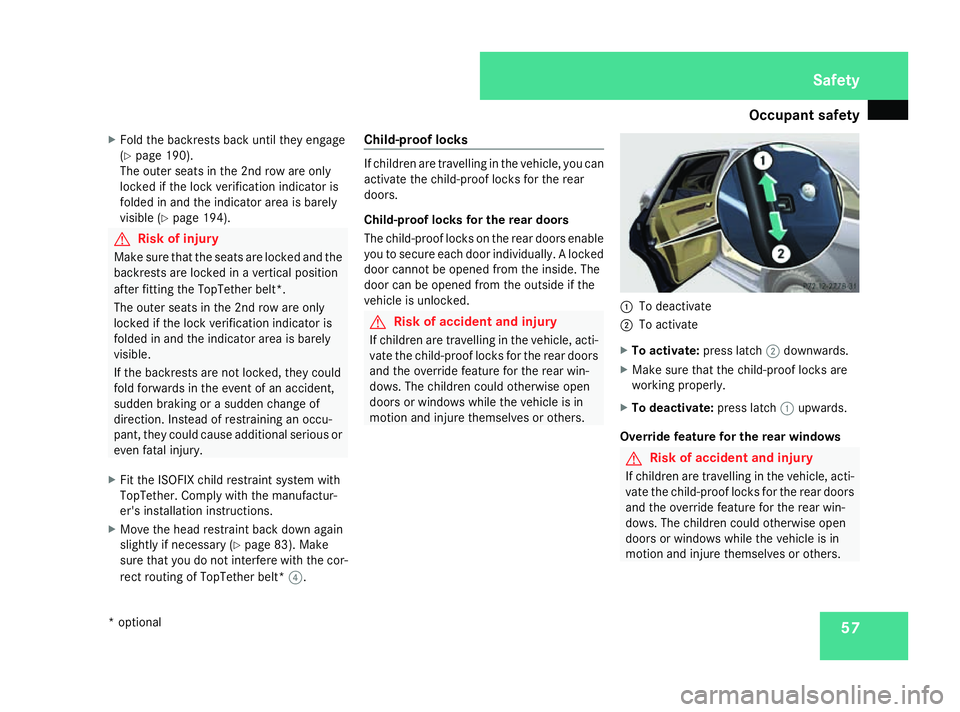
Occupant safety
57
X
Fold the backrests back until they engage
(Y page 190).
The outer seats in the 2nd row are only
locked if the lock verification indicator is
folded in and the indicator area is barely
visible (Y page 194). G
Risk of injury
Make sure that the seats are locked and the
backrests are locked in a vertical position
after fitting the TopTether belt*.
The outer seats in the 2nd row are only
locked if the lock verification indicator is
folded in and the indicator area is barely
visible.
If the backrests are not locked, they could
fold forwards in the event of an accident,
sudden braking or a sudden change of
direction. Instead of restraining an occu-
pant, they could cause additional serious or
even fatal injury.
X Fit the ISOFIX child restraint system with
TopTether. Comply with the manufactur-
er's installation instructions.
X Move the head restraint back down again
slightly if necessary (Y page 83). Make
sure that you do not interfere with the cor-
rect routing of TopTether belt* 4.Child-proof locks If children are travelling in the vehicle, you can
activate the child-proof locks for the rear
doors.
Child-proof locks for the rear doors
The child-proof locks on the rear doors enable
you to secure each door individually. A locked
door cannot be opened from the inside. The
door can be opened from the outside if the
vehicle is unlocked.
G
Risk of accident and injury
If children are travelling in the vehicle, acti-
vate the child-proof locks for the rear doors
and the override feature for the rear win-
dows. The children could otherwise open
doors or windows while the vehicle is in
motion and injure themselves or others. 1
To deactivate
2 To activate
X To activate: press latch2downwards.
X Make sure that the child-proof locks are
working properly.
X To deactivate: press latch1upwards.
Override feature for the rear windows G
Risk of accident and injury
If children are travelling in the vehicle, acti-
vate the child-proof locks for the rear doors
and the override feature for the rear win-
dows. The children could otherwise open
doors or windows while the vehicle is in
motion and injure themselves or others. Safety
* optional
251_AKB; 5; 7, en-GB
wobuchh,
Version: 2.10.6 2008-05-11T14:51:51+02:00 - Seite 57 ZDateiname: 6515_1825_02_buchblock.pdf; preflight